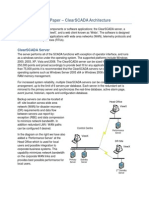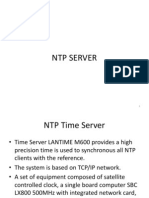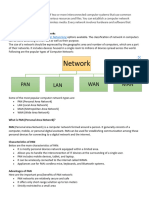0% found this document useful (0 votes)
141 views6 pagesNetwork Notes
There are several types of computer networks that differ in size and purpose. Local Area Networks (LANs) connect devices within a limited local area like a home, school, or office building. Metropolitan Area Networks (MANs) span a larger region like a city or campus and use connections like fiber optic cables. Wide Area Networks (WANs) connect LANs across broad geographic areas and are often used by organizations with multiple office locations. Each network type has advantages like resource sharing but also challenges like setup costs or maintenance difficulties.
Uploaded by
NMCopyright
© © All Rights Reserved
We take content rights seriously. If you suspect this is your content, claim it here.
Available Formats
Download as PDF, TXT or read online on Scribd
0% found this document useful (0 votes)
141 views6 pagesNetwork Notes
There are several types of computer networks that differ in size and purpose. Local Area Networks (LANs) connect devices within a limited local area like a home, school, or office building. Metropolitan Area Networks (MANs) span a larger region like a city or campus and use connections like fiber optic cables. Wide Area Networks (WANs) connect LANs across broad geographic areas and are often used by organizations with multiple office locations. Each network type has advantages like resource sharing but also challenges like setup costs or maintenance difficulties.
Uploaded by
NMCopyright
© © All Rights Reserved
We take content rights seriously. If you suspect this is your content, claim it here.
Available Formats
Download as PDF, TXT or read online on Scribd
/ 6

























































































